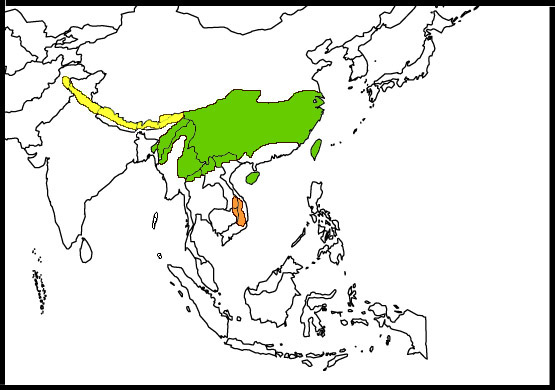(Photo captions. List of references) |
|||
| Line 1: | Line 1: | ||
'''Alternative names: Red-headed Tit; Black-throated Bushtit''' | '''Alternative names: Red-headed Tit; Black-throated Bushtit''' | ||
| − | [[Image:Black-throated_Tit.jpg|thumb|550px|right|Photo by {{user|MoonCake|MoonCake}}<br /> | + | [[Image:Black-throated_Tit.jpg|thumb|550px|right|Subspecies ''concinnus''<br />Photo by {{user|MoonCake|MoonCake}}<br /> [[Taiwan]]]] |
;[[:Category:Aegithalos|Aegithalos]] concinnus | ;[[:Category:Aegithalos|Aegithalos]] concinnus | ||
==Identification== | ==Identification== | ||
| Line 37: | Line 37: | ||
|} | |} | ||
==Taxonomy== | ==Taxonomy== | ||
| − | [[Image:1853blackthroatedtitnet.jpg|thumb|350px|right|Photo by {{user|Sumit|Sumit}}<br /> | + | [[Image:1853blackthroatedtitnet.jpg|thumb|350px|right|Subspecies ''iredalai''<br />Photo by {{user|Sumit|Sumit}}<br />Eastern [[Himalayas]], [[India]]]] |
Marked geographical variation. This species may represent an unresolved species swarm, further study is needed.<br /> | Marked geographical variation. This species may represent an unresolved species swarm, further study is needed.<br /> | ||
Six subspecies are recognized, forming three groups: | Six subspecies are recognized, forming three groups: | ||
| Line 62: | Line 62: | ||
==References== | ==References== | ||
# {{Ref-HBWVol13}}# {{Ref-RasmussenAnderton05}} | # {{Ref-HBWVol13}}# {{Ref-RasmussenAnderton05}} | ||
| + | {{ref}} | ||
==External Links== | ==External Links== | ||
{{GSearch|Aegithalos+concinnus}} | {{GSearch|Aegithalos+concinnus}} | ||
[[Category:Birds]] [[Category:Aegithalos]] [[Category: Maps]] | [[Category:Birds]] [[Category:Aegithalos]] [[Category: Maps]] | ||
Revision as of 23:10, 3 May 2010
Alternative names: Red-headed Tit; Black-throated Bushtit
- Aegithalos concinnus
Identification
10cm.
A widespread and common long-tailed tit with marked geographical variation.
Iredalai-group:
- Rufous crown
- Black throat-patch below white chin
- Small whitish supercilium
- Cool grey above
- Whitish below with rufescent flanks
- Pale yellow iris
Annamensis-group:
- Crown grey
- No whitish supercilium, generally less white on head
- Greyish-white below
Concinnus-group:
- Chestnut flanks
- Chestnut lower breast band
- Whitish central belly
- pulchellus with grey crown, others with rufous crown
The sexes are similar, juveniles have paler caps.
Distribution
| Found from northern Pakistan east along the Himalayas to India, Nepal, Bhutan and northeast India. Also in northwest Burma, northwest Thailand, Laos, Cambodia, Vietnam and much of southern China, including Hainan and in Taiwan. | |
| Legend • iredalai-group; year-round |
Taxonomy
Marked geographical variation. This species may represent an unresolved species swarm, further study is needed.
Six subspecies are recognized, forming three groups:
- iredalai-group:
- annamensis-group:
- nominate-group:
Habitat
Broadleaved (especially oak) and mixed forest up to 2700m, but also recorded higher up.
Behaviour
This species is mostly resident. Some erratic and altitudinal movements are known.
Very gregarious foraging usually in flocks of up to 40 birds. Often joins mixed-species parties.
Diet
Feeds on insects. Also known to take small seeds and fruits.
Breeding
Breeding season from February to May in China, March to May in the Himalayas. Single-brooded, sometimes with helpers. The nest is an oval ball made from lichen and moss, bound together with spider webs. It's placed in a fork up to 3m high or woven around twigs. 3 - 6 white or pale pink eggs are laid.
Vocalisation
Psip-psip notes and a chrr-chrr, trr-trr.
References
- Del Hoyo, J, A Elliott, and D Christie, eds. 2008. Handbook of the Birds of the World. Volume 13: Penduline-tits to Shrikes. Barcelona: Lynx Edicions. ISBN 978-8496553453
- Rasmussen, PC and JC Anderton. 2005. Birds of South Asia: The Ripley Guide. Barcelona: Lynx Edicions. ISBN 978-8487334672
Recommended Citation
- BirdForum Opus contributors. (2024) Black-throated Tit. In: BirdForum, the forum for wild birds and birding. Retrieved 28 April 2024 from https://www.birdforum.net/opus/Black-throated_Tit






